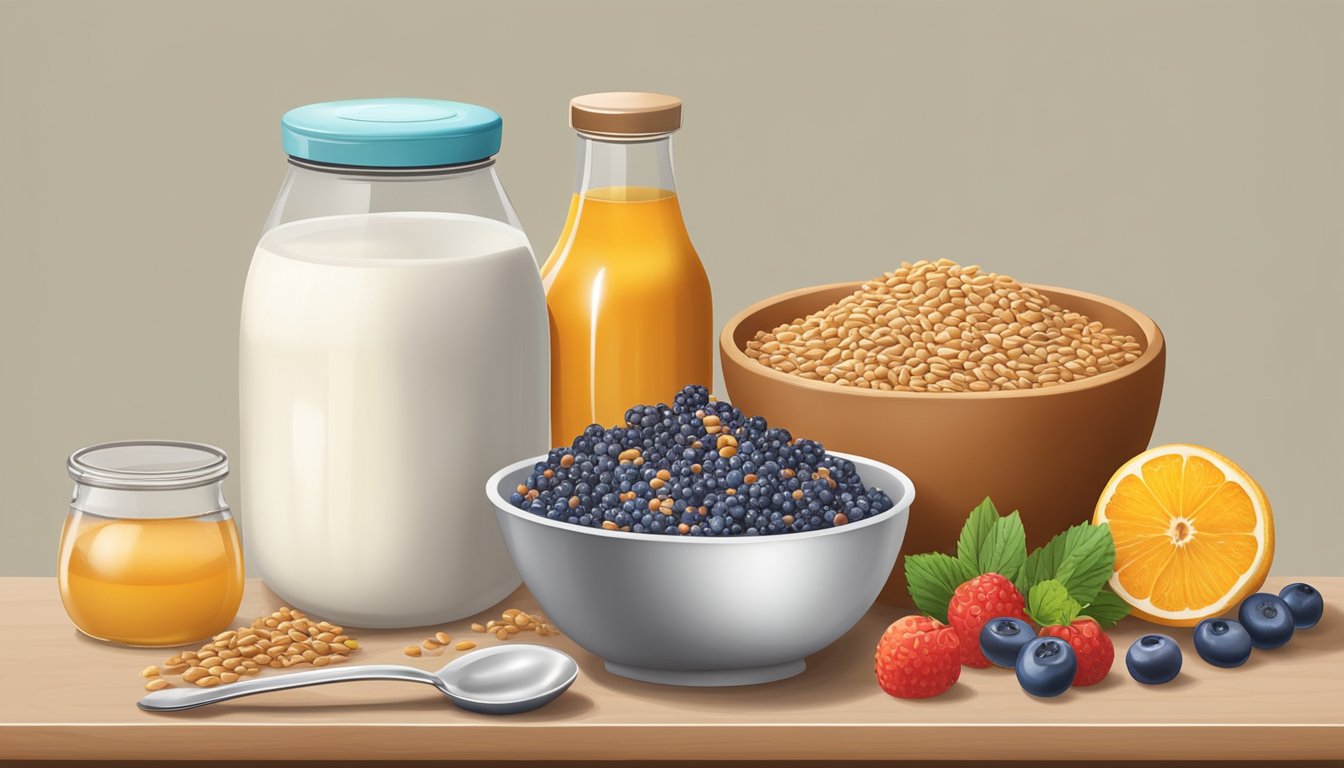Spelt berries are a nutritious powerhouse that can revolutionize your breakfast routine. These ancient grains pack a punch with their high protein content and numerous health benefits. One cup of cooked spelt berries contains approximately 10.67 grams of protein, making them an excellent choice for those seeking a nutritious start to their day.
As a whole grain, spelt berries offer a wealth of dietary fiber, vitamins, and minerals. Their nutty flavor adds depth to various breakfast dishes, from porridges to granolas. Incorporating spelt berries into your morning meal can provide sustained energy and support overall well-being.
This guide will explore the versatility of spelt berries in breakfast preparations. From simple cooking methods to creative recipes, you’ll discover how to transform these nutritious grains into delicious and satisfying morning meals. Whether you’re health-conscious or simply looking to diversify your breakfast options, spelt berries offer a compelling alternative to traditional breakfast staples.
Understanding Spelt Berries
Spelt berries are nutrient-dense ancient grains with a rich history and impressive health benefits. These whole grains offer a unique nutritional profile that sets them apart from other cereals.
History and Background
Spelt is an ancient grain that dates back over 8,000 years. It originated in the Fertile Crescent and spread throughout Europe during the Bronze Age. Spelt was a staple food in many ancient civilizations, including the Greeks and Romans.
Unlike modern wheat, spelt has remained largely unchanged over millennia. This grain fell out of favor with the rise of industrialized agriculture but has experienced a resurgence in recent years due to its nutritional value and lower gluten content.
Spelt belongs to the wheat family but has a distinct genetic makeup. Its tough outer husk protects the grain from pests and preserves nutrients, making it a hardy and resilient crop.
Nutritional Profile
Spelt berries boast an impressive nutritional profile, packed with essential nutrients. They are an excellent source of complex carbohydrates, providing sustained energy throughout the day.
One cup of cooked spelt berries contains:
- Calories: 246
- Protein: 10.67g
- Fiber: 7.6g
- Iron: 3.2mg
- Magnesium: 95mg
Spelt is rich in B vitamins, particularly niacin and thiamin. It also contains significant amounts of zinc, phosphorus, and selenium.
The grain’s high fiber content supports digestive health and helps maintain stable blood sugar levels. Spelt’s protein content is higher than that of common wheat, making it a valuable option for vegetarian and vegan diets.
Health Benefits
Spelt berries offer numerous health benefits due to their nutrient density. The high fiber content aids digestion and promotes a healthy gut microbiome. This can lead to improved overall digestive health and regularity.
The grain’s complex carbohydrates provide sustained energy release, helping to stabilize blood sugar levels. This makes spelt a good choice for people managing diabetes or seeking to control their weight.
Spelt’s mineral content, particularly iron and magnesium, supports various bodily functions. Iron is crucial for oxygen transport in the blood, while magnesium plays a role in muscle and nerve function.
The B vitamins in spelt contribute to energy metabolism and cognitive function. These nutrients are essential for maintaining overall health and well-being.
Spelt vs. Other Whole Grains
Spelt stands out among whole grains for several reasons. Its protein content is higher than that of common wheat, making it a more filling option. Spelt also has a lower gluten content, which some people find easier to digest.
Compared to other ancient grains like quinoa or amaranth, spelt has a milder, nuttier flavor. This makes it versatile in both sweet and savory dishes.
Nutritionally, spelt is similar to other whole grains but excels in certain areas:
| Nutrient | Spelt | Wheat | Oats |
|---|---|---|---|
| Protein (g/cup) | 10.67 | 7.5 | 6.5 |
| Fiber (g/cup) | 7.6 | 6.4 | 4.0 |
| Iron (mg/cup) | 3.2 | 3.5 | 1.7 |
While spelt contains phytic acid, which can inhibit mineral absorption, its levels are lower than in some other grains. Soaking or sprouting spelt berries can further reduce phytic acid content.
Preparation of Spelt Berries
Preparing spelt berries involves several key steps to ensure optimal taste and texture. The process includes rinsing, soaking, and cooking using various methods.
Rinsing and Soaking
Start by rinsing spelt berries under cold running water to remove any debris. Place them in a bowl and cover with water. Add a splash of vinegar to aid in breaking down the grain’s outer layer. Soak for a few hours or overnight.
Soaking softens the berries and reduces cooking time. It also helps to activate enzymes, making nutrients more bioavailable. After soaking, drain and rinse the berries again before cooking.
Cooking Methods
Spelt berries can be cooked using several methods:
- Stovetop: Add berries to a pot with water or broth. Bring to a boil, then simmer.
- Slow cooker: Ideal for hands-off cooking. Cook on high for 3-4 hours.
- Pressure cooker: Fastest method, typically taking 20-30 minutes.
Each method yields slightly different textures. Experiment to find your preferred approach.
Cooking Time and Texture
Cooking time varies based on the method used and desired texture. Stovetop cooking typically takes 50-60 minutes. Slow cookers require 3-4 hours on high. Pressure cookers need about 20-30 minutes.
For al dente texture, cook for less time. For softer berries, extend cooking. Check periodically and add water if needed. Cooked spelt berries should be chewy but not tough.
Properly cooked spelt berries can be used immediately or stored for meal prep. They’re versatile in both hot and cold dishes.
Breakfast Recipes with Spelt Berries
Spelt berries offer a nutritious and versatile base for various breakfast dishes. From classic porridge to innovative pancakes and creative bowls, these ancient grains can transform your morning meal.
Classic Spelt Berry Porridge
Spelt berry porridge provides a hearty start to the day. Rinse 1 cup of spelt berries and cook them in 3 cups of water for about 40 minutes until tender. Drain any excess water and return the berries to the pot.
Add 1 cup of milk and simmer for 5-10 minutes until it reaches your desired consistency. Stir in a pinch of salt and sweeten with honey or maple syrup to taste.
For added flavor and nutrition, top your porridge with fresh fruits, nuts, or a sprinkle of cinnamon. This simple recipe can be customized to suit various dietary preferences and taste preferences.
Spelt Berry Pancakes
Transform spelt berries into delicious pancakes for a unique breakfast treat. Grind cooked spelt berries in a food processor to create a coarse flour. Mix 1 cup of this flour with 1 cup of whole wheat flour, 2 teaspoons of baking powder, and a pinch of salt.
In a separate bowl, whisk together 2 eggs, 1 1/2 cups of milk, and 2 tablespoons of melted butter. Combine the wet and dry ingredients, stirring until just mixed.
Cook the pancakes on a preheated griddle until golden brown on both sides. Serve with fresh berries, a dollop of yogurt, or a drizzle of pure maple syrup.
Creative Spelt Berry Bowls
Spelt berry bowls offer endless possibilities for a nutritious and satisfying breakfast. Start with a base of cooked spelt berries and add layers of flavor and texture.
For a savory bowl, top spelt berries with sautéed vegetables, a poached egg, and a sprinkle of cheese. Add a dash of hot sauce for extra zest.
Create a sweet version by mixing cooked spelt berries with Greek yogurt and a swirl of honey. Top with sliced almonds, fresh fruit, and a dusting of cinnamon.
For a tropical twist, combine spelt berries with coconut milk, diced mango, and toasted coconut flakes. These creative bowls can be customized to suit any taste preference or dietary need.
Enhancing Flavors and Textures

Spelt berries offer a versatile canvas for creating delicious breakfast dishes. Their nutty flavor and chewy texture can be enhanced through various techniques and pairings.
Sweetening Techniques
Spelt berries can be sweetened naturally to create a satisfying breakfast. Drizzle maple syrup or honey over cooked spelt berries for a quick and easy sweetener. For a more complex flavor, try coconut sugar or date syrup.
Sprinkle cinnamon or nutmeg on top for a warm, comforting taste. Mix in a tablespoon of cocoa powder for a chocolatey twist. Experiment with vanilla extract or almond essence to add depth to the flavor profile.
For a healthier option, mash a ripe banana into the cooked spelt berries. This adds natural sweetness and a creamy texture.
Pairing with Fruits and Sweeteners
Fresh fruits complement spelt berries beautifully, adding both flavor and nutrition. Top cooked spelt with sliced strawberries, cherries, or peaches for a burst of freshness.
Roasted fruits offer a different dimension. Toss apple chunks with cinnamon and bake until tender. These cinnamon apples pair wonderfully with spelt berries, creating a warm and comforting breakfast.
For a tropical twist, add diced mango or pineapple. Dried fruits like raisins, cranberries, or chopped dates can be stirred in during cooking to infuse the spelt with their sweetness.
Consider creating a fruit compote by simmering berries with a touch of honey. Spoon this over the spelt for a luxurious breakfast treat.
Savory Variations
Spelt berries aren’t limited to sweet preparations. They can be the base for savory breakfast bowls too. Cook spelt berries in vegetable or chicken broth for added flavor.
Stir in sautéed mushrooms, spinach, and garlic for a hearty breakfast. Top with a poached egg and sprinkle with grated Parmesan cheese.
For a Mediterranean twist, mix in diced tomatoes, cucumbers, and crumbled feta cheese. Drizzle with olive oil and sprinkle with oregano.
Try a Mexican-inspired version with black beans, diced avocado, and a dollop of salsa. Add a squeeze of lime juice for brightness.
Experiment with different spices like cumin, paprika, or za’atar to create unique flavor profiles.
Nutrient Retention and Dietary Considerations

Spelt berries offer significant nutritional benefits, but their consumption requires careful consideration of certain dietary factors. These factors include gluten content, phytic acid levels, and integration into a balanced diet.
Gluten Content and Sensitivity
Spelt contains gluten, making it unsuitable for those with celiac disease or gluten sensitivity. While some people with mild wheat sensitivities may tolerate spelt better, it’s not a gluten-free option.
Whole spelt flour retains more nutrients than white spelt flour but has higher gluten content. Those with gluten-related concerns should consult a healthcare professional before incorporating spelt into their diet.
Phytic Acid and Mineral Absorption
Spelt berries contain phytic acid, which can bind to minerals and reduce their absorption. Soaking or sprouting spelt berries before cooking can help reduce phytic acid levels.
This process may improve the bioavailability of minerals like phosphorus, iron, and zinc. However, phytic acid also has potential health benefits, including antioxidant properties.
Balancing phytic acid intake with proper food preparation techniques can optimize nutrient absorption from spelt berries.
Integrating Spelt into a Healthy Diet
Spelt berries are rich in dietary fiber, contributing to digestive health and promoting satiety. They can be a valuable addition to a balanced diet, offering variety and nutritional benefits.
Organic spelt berries may have higher nutrient content and fewer pesticide residues. Incorporating spelt into meals can be as simple as substituting it for rice or other grains in recipes.
For optimal nutrition, combine spelt with a variety of other whole grains, vegetables, and protein sources. This approach ensures a diverse nutrient intake and supports overall health.
Versatility in Cooking with Spelt
Spelt offers remarkable versatility in the kitchen, adapting well to various cooking methods and recipes. Its nutty flavor and chewy texture make it a valuable ingredient across many cuisines.
Substituting Spelt in Common Dishes
Spelt can replace other grains in numerous dishes. Use it instead of rice in pilafs or risottos for a nuttier flavor and chewier texture. Substitute spelt berries for barley in soups or stews to add heartiness.
In salads, spelt can stand in for farro or wheat berries. Cook spelt berries until tender, then cool and toss with vegetables, herbs, and dressing for a nutritious grain salad.
For a breakfast option, cook spelt berries like oatmeal. Simmer in water or milk until soft, then add toppings like fruit, nuts, and honey.
Spelt in Soups and Salads
Spelt excels in soups and salads, adding substance and nutrition. In soups, add cooked spelt berries during the last 15-20 minutes of cooking to maintain their texture.
For cold salads, cook spelt berries until tender but still firm. Drain and cool before mixing with crisp vegetables, herbs, and a tangy vinaigrette. Spelt pairs well with roasted vegetables, feta cheese, and leafy greens in Mediterranean-style salads.
Try a warm spelt salad by tossing cooked berries with sautéed mushrooms, spinach, and a light lemon dressing. This makes a satisfying side dish or vegetarian main course.
Baking with Spelt Flour
Spelt flour offers a nutritious alternative to wheat flour in baking. It can be used in breads, muffins, cookies, and pancakes. When substituting spelt flour for wheat flour, use slightly less liquid as spelt absorbs more moisture.
For yeast breads, blend spelt flour with wheat flour for better rise and texture. Start by replacing 25% of the wheat flour with spelt, adjusting as needed.
In quick breads and muffins, spelt flour can often replace 100% of the wheat flour. Its nutty flavor enhances whole grain recipes. For lighter textures in cakes and pastries, use a mix of whole spelt flour and white spelt flour.
Experiment with spelt flakes in granola or as a topping for fruit crisps. Their delicate texture and sweet flavor add interest to baked goods.
Tips for Storing and Preserving Spelt
Proper storage is crucial for maintaining the quality and freshness of spelt berries. Keep them in an airtight container in a cool, dry place away from direct sunlight. This will help prevent moisture and pests from compromising the grains.
For long-term storage, consider using food-grade buckets with tight-fitting lids. These can protect spelt berries for up to a year when stored in a temperature-controlled environment.
Freezing is an excellent option for extending the shelf life of spelt. Place the berries in freezer-safe bags, removing as much air as possible before sealing. Frozen spelt can last for several years without significant quality loss.
When preparing spelt for meal prep, cook a large batch and portion it into containers. Cooked spelt berries can be refrigerated for up to 5 days or frozen for up to 3 months.
To enhance the nutritional value and digestibility of spelt, consider soaking the berries overnight before cooking. This process can be done using water or non-dairy milk for added flavor.
Label your stored spelt with the date of purchase or preparation. This practice helps track freshness and ensures you use older stock first, minimizing waste.
Incorporating Spelt into Special Diets

Spelt berries offer versatility for various dietary needs. They provide nutritious options for plant-based eaters and those with gluten sensitivities.
Vegetarian and Vegan Options
Spelt berries shine in vegetarian and vegan diets. Their high protein content makes them an excellent meat substitute.
For breakfast, try a spelt berry porridge with non-dairy milk and fresh fruits. Almond or oat milk complement spelt’s nutty flavor well.
Spelt can replace rice or quinoa in grain bowls. Mix cooked spelt berries with roasted vegetables and a tahini dressing for a satisfying meal.
Vegans can use spelt flour to make egg-free pancakes or waffles. Combine it with ground flaxseed as an egg replacer for a protein-packed breakfast.
Low-Gluten Diet Adjustments
While not gluten-free, spelt contains less gluten than common wheat. Some with mild gluten sensitivities may tolerate it better.
Always consult a doctor before adding spelt to a gluten-sensitive diet. Start with small amounts to test tolerance.
For those who can consume spelt, use it to make low-gluten bread or muffins. Mix spelt flour with gluten-free flours for a lighter texture.
Spelt berries can replace oats in granola recipes. Combine them with nuts and seeds for a crunchy, low-gluten breakfast topping.
Consider sprouting spelt berries before cooking. This process may make them easier to digest for some individuals.
Advanced Techniques and Tools

Elevate your spelt berry breakfast with specialized equipment and creative flavoring methods. These approaches enhance texture, deepen flavors, and streamline preparation.
Utilizing a Slow Cooker or Pressure Cooker
Slow cookers and pressure cookers offer hands-off methods for perfectly cooked spelt berries. For slow cookers, combine 1 cup spelt berries with 3 cups water or vegetable broth. Cook on low for 6-8 hours or high for 3-4 hours until tender.
Pressure cookers dramatically reduce cooking time. Add 1 cup spelt berries and 3 cups liquid to the pot. Cook at high pressure for 20-25 minutes, then allow natural pressure release. Both methods yield tender, flavorful spelt berries ready for customization.
For extra depth, toast spelt berries in a dry skillet before cooking. This brings out their nutty flavor and adds complexity to the final dish.
Making Creamy Spelt Porridge
Transform cooked spelt berries into a luxurious porridge. Start with fully cooked berries and add milk or plant-based alternatives. Simmer over low heat, stirring frequently until desired consistency is reached.
For ultra-creaminess, blend a portion of the cooked spelt berries before adding back to the pot. This creates a smoother texture while maintaining some whole grains for interest.
Add a touch of butter or coconut oil for richness. Sweeten with honey, maple syrup, or date paste to taste. For a savory twist, use vegetable broth as the cooking liquid and top with a poached egg.
Herbs and Spice Combinations
Elevate spelt berry breakfasts with thoughtful herb and spice pairings. For a warming blend, mix cinnamon, nutmeg, and cardamom. Stir into porridge or sprinkle over cooked berries.
Fresh herbs add brightness. Try chopped basil or mint with summer berries. For a savory profile, incorporate thyme, rosemary, or sage.
Experiment with global flavors:
- Middle Eastern: za’atar, sumac, and lemon zest
- Indian-inspired: turmeric, ginger, and black pepper
- Mexican: chili powder, cumin, and lime juice
Toast whole spices before grinding for maximum impact. Bloom ground spices in hot oil or butter before adding to your spelt dish to intensify their flavors.




